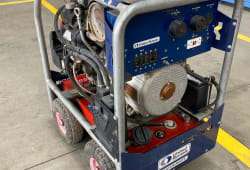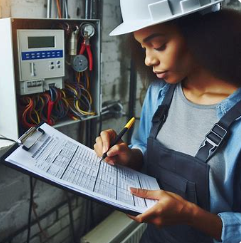Choosing The Right Size of Generator for Your Needs
2 Min read
)
August 20, 2024
Choosing the right generator for your needs involves calculating the total wattage required by the equipment you'll be powering, considering both running and starting wattage. For smaller tasks or light power tools, a generator with 4,000-6,000 watts may suffice, while medium-sized construction sites with larger tools like welders or concrete mixers typically need 7,000-12,000 watts. For heavy-duty or multi-crew operations, a generator with 12,000-20,000+ watts is usually necessary. Properly sizing your generator ensures it can handle peak loads efficiently without overloading.
Residential Generators
The size of the generator you need depends on the total wattage of the appliances and devices you want to power. Here’s how you can estimate:
Determine Your Power Needs: List all the devices you plan to run, such as refrigerators, air conditioners, lights, and electronics, and their starting and running wattage.
For example:
Fridge: 600-800 watts (starting watts may be higher)
Lights: 60-300 watts
AC unit: 2,000-4,000 watts
Add up the Wattage: Add the total running wattage of the devices. If any devices have higher starting wattage (like motors or compressors), include those as well.
Choose a Generator Size:
Small generator (3,000-4,000 watts): For powering essential items like a fridge, some lights, and small electronics.
Medium generator (5,000-7,500 watts): Can handle larger appliances like an air conditioner, water heater, or more household circuits.
Large generator (8,000-10,000+ watts): Suitable for whole-house power needs or running multiple large appliances simultaneously.
Once you have a list of the wattages, choosing a generator becomes clearer.
Commercial Generators
For a construction site, the generator size depends on the types of tools and equipment you'll be running. Here's a breakdown:
Light Power Tools: Drills, saws, small compressors:
Small generator (4,000-6,000 watts) is typically sufficient.
Larger Equipment: Welders, multiple compressors, concrete mixers:
Medium generator (7,000-12,000 watts) is often needed to support heavier tools.
Heavy-Duty Use: Cranes, large air compressors, multiple crews using power tools:
Large generator (12,000-20,000+ watts) may be necessary for powering multiple pieces of equipment simultaneously.
It's best to total up the wattage of the tools you'll be using and choose a generator that can handle the peak loads. For example, a jackhammer might require 2,000-3,000 watts alone, while a table saw might need 1,500-2,000 watts.

Rex Walz is Boom & Bucket's Manager of Supplier Relations, bringing over a decade of experience in B2B sales and heavy equipment solutions. With a background spanning government, construction, industrial, and commercial sectors, he has a proven track record of driving growth and building trusted customer relationships. At Boom & Bucket, Rex is passionate about helping partners succeed while advancing the company's mission to create the most trusted marketplace for heavy equipment.






